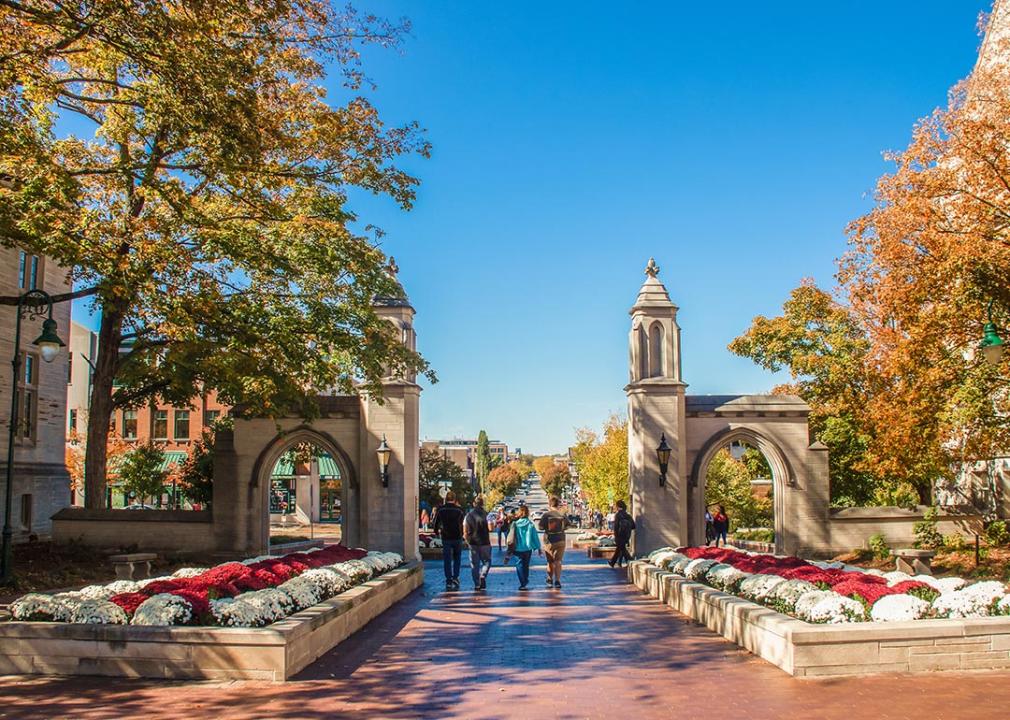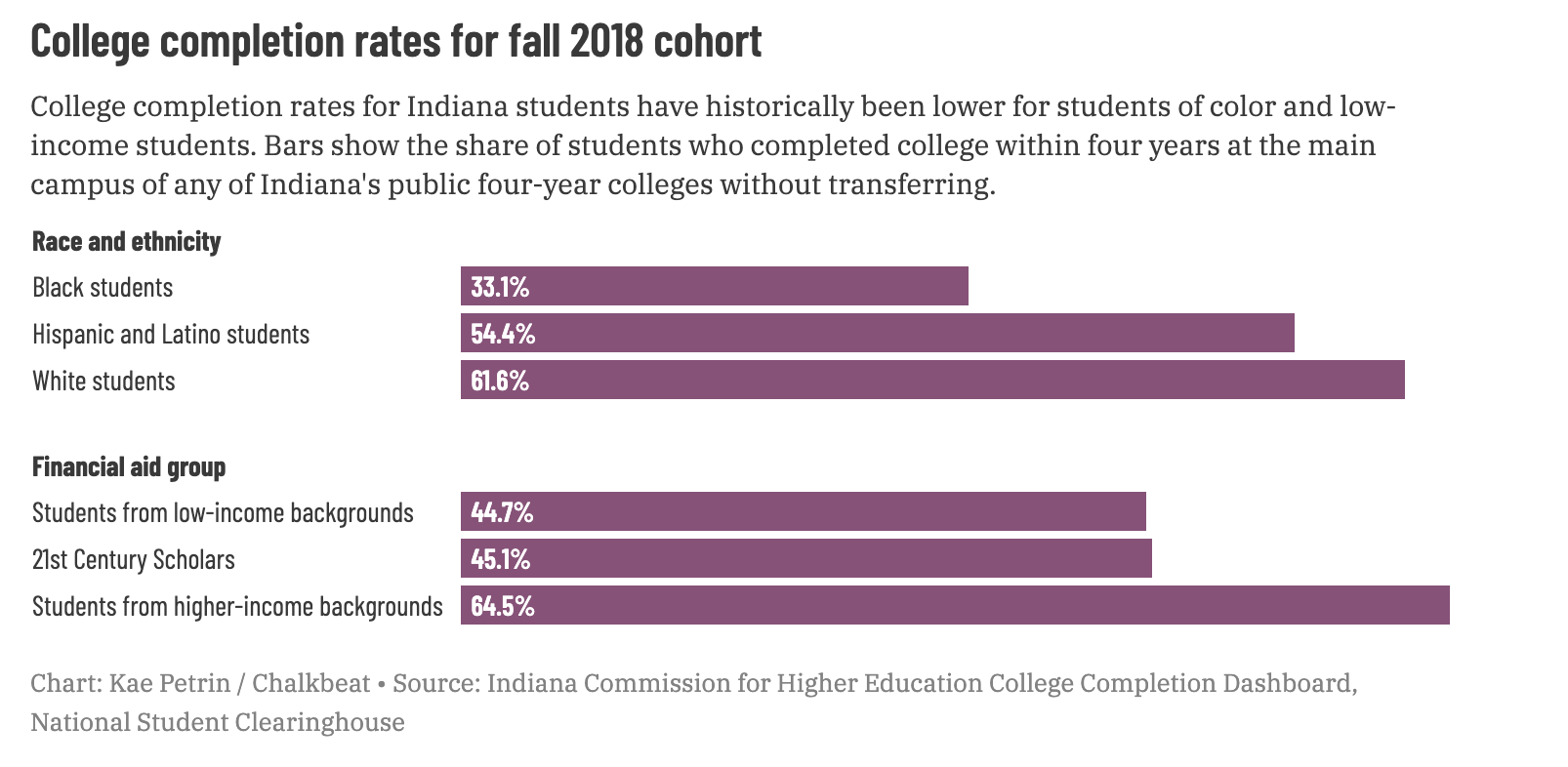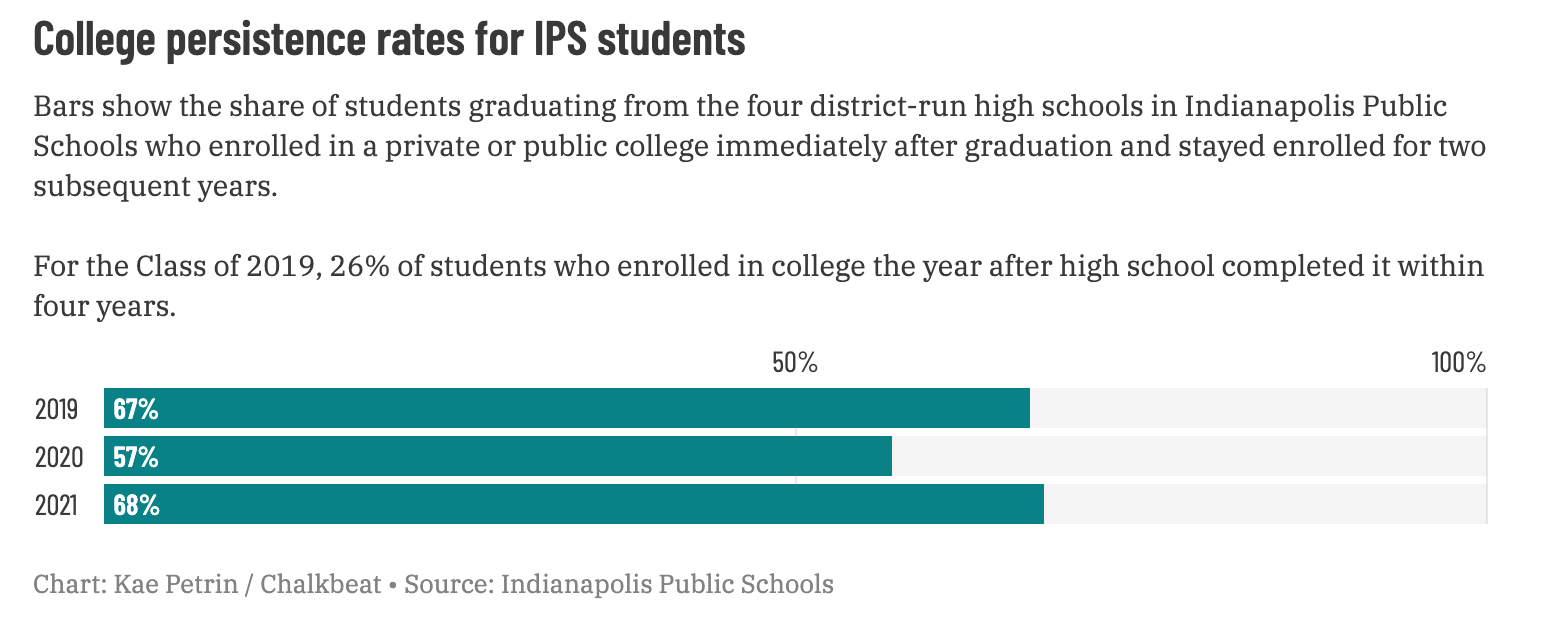This state is expanding college access, but are students actually prepared to earn a degree?

Vineyard Perspective // Shutterstock
This state is expanding college access, but are students actually prepared to earn a degree?
Indiana University college campus in Bloomington, Indiana.
As a teenager, Mike Utley’s college prep often came via Google and Reddit.
He had few people he felt he could turn to for advice, so he searched for answers online. He also reviewed pamphlets and went on college visits — but even the tours, he said, felt like going to the zoo and looking at an exhibit through glass.
“The concept of what this thing was was so foreign to me, that every part of college life was an adjustment,” said Utley, who graduated from Indianapolis’ Shortridge High School in 2018 and was a first-generation college student. “Every single part.”
As reported by Chalkbeat, once he enrolled at Indiana University Bloomington, several factors made life challenging. His mother was battling cancer. He switched majors multiple times within the Kelley School of Business without finding a subject he was passionate about studying. And looking back, he said, he didn’t have a good understanding of his own mental health.
He dropped out in 2021, during the second semester of his junior year. In fact, of the Indianapolis Public Schools students like Utley who graduated in 2018 and enrolled in a public, in-state four-year college within a year of graduation, just 23.6% graduated on time, according to data from the Indiana Commission for Higher Education. Fewer than 6 in 10 made it to their second year at any public state institution.
In Indianapolis and across the state, education officials and legislators have enacted several initiatives designed to expand college access and increase college enrollment. Students frequently hear about the benefits of higher education. But the experiences of people like Utley raise a key question: Are students actually prepared enough to finish it, even if their academic records suggest they are?
The recent expansion of college-access programs might make the answer to that question more important.
Indiana students in seventh and eighth grade who are eligible for free or reduced-price lunch are now automatically enrolled in the state’s 21st Century Scholars program, which offers college tuition for qualifying students (Utley participated in this program). Every high school student in Indiana must now fill out the Free Application for Federal Student Aid.
And this year, IU Indianapolis will admit its first round of IPS students through an automatic admissions program for students with a GPA of at least 3.0.
Research suggests that college completion in Indiana and elsewhere is often hardest for students of color, students from low-income families, and those who are the first in their family to attend college. Researchers and experts say students withdraw from college for several reasons, and students of color in particular can struggle to feel at home on many campuses.
![]()

Kae Petrin // Chalkbeat
Societal inequities affect students from pre-K through 12th grade
Graph showing results for “College completion rates for fall 2018 cohort”
Low college completion rates are rooted in societal inequities that affect students beginning in prekindergarten and pose major challenges to K-12 schools, said Bryan Cook, director of higher education policy for the Center on Education Data and Policy at the Urban Institute.
“There are inequities that are not getting addressed in K-12 among different populations of students by race and income, and those inequities perpetuate themselves in higher education,” Cook said, “even if students are able to be successful in high school to the point where they can get admitted into a four-year college.”
Both IPS — which says different data paints a better picture for its graduates — and higher education institutions say they’re working on the issue in various ways.
Officials in the college prep space must focus on systemic issues like homelessness, a lack of transportation, and food insecurity that can affect students’ emotional and social readiness for college, said Joe Zachery Jr., the director of the College Prep Institute at the Center for Leadership Development in Indianapolis.
“Yes, you were exposed to good education,” he said. “But you’re not really focused on that because you’re having a difficult time just surviving on a daily basis.”
Leaving high school unprepared for college
Utley, who is Black, said his family didn’t have a lot growing up. He and his siblings moved between shelters and other transitional housing with their mother.
But he still did well in IPS. He attended Sidener Academy, the district’s school for high-ability students. He did International Baccalaureate classes at Shortridge High School, where he said college enrollment was heavily stressed. He said he had a high school GPA of about 3.8.
Academically, he said, his high school experience prepared him for college. But in other ways, it did not.
He wishes someone had helped him understand college majors and careers, or how to take an effective gap year and explore career options. In general, he said, he needed someone to demystify adulthood.
“My high school was real big on, ‘This is a college prep school,’ so I understand why … they were so adamant on college enrollment, and that’s it,” he said. “But that’s not it.”
IPS officials say college completion rates for graduates have improved since 2018, based on National Student Clearinghouse data that includes private, public, and out-of-state colleges. But they have also boosted efforts at college preparation since Utley’s graduation in 2018.

Kae Petrin // Chalkbeat
Centers rise to help students prepare for life choices after high school
Graph showing results for “College persistence rates for IPS students.”
These include the 2018 launch of Future Centers at each of the district’s four traditional high schools, and the creation of a Postsecondary Readiness team around the same time.
The goal of these centers, officials say, is to prepare students for college, employment, or enlistment in the military. Next school year, the district hopes to boost staffing at these centers by adding a college and career counselor and a college specialist.
But students from challenging circumstances like many in IPS, where nearly 70% of students qualify for free or reduced-price meals due to their low-income backgrounds, need not just academic but also social support, said Carey Dahncke, executive director of the Center of Excellence in Leadership of Learning at the University of Indianapolis.
Dahncke’s center runs the Urban College Acceleration Network, which helps high schools in IPS and other districts become Early College High Schools accredited through the center. These schools not only offer dual credit options for future academic success, but also help students with early planning so they understand how higher education works and college coursework, Dahncke said.
“The theory with early college is if you understand the gaps, the problems that exist, you can put interventions in place to get a different outcome,” Dahncke said.
‘I wanted to make money because I was poor’
Enamored by the prestige and reputation of IU’s business school, he chose to enroll there — even though he naturally gravitated toward art.
“I wanted to make money because I was poor, and I’m going to the business school — that’s where they make all the money,” he said. “That was the mentality.”
The pressure of being a first-generation student and attending a prestigious program also piled on.
“You owe it to your community, you owe it to your parents, you owe it to your siblings, you owe it to the next generation to be successful,” he said. “Every decision I made until I was a sophomore was in relation to that pressure.”
Utley’s home life made college even harder: He frequently returned to Indianapolis to see his mother, who was battling cancer, and at times that led him to miss classes. Then his mother passed away in 2020. All these factors culminated in his withdrawal from IU.
At IU Bloomington, Black students complete college on time at the same campus at a lower rate than white or Asian students. The trend is similar at other public university campuses where many IPS students go, including Indiana University-Purdue University Indianapolis and Ball State. (IUPUI will split into IU Indianapolis and Purdue University in Indianapolis later this year.)
Among students who, like Utley, entered IU Bloomington in 2018, only 51.5% of Black students finished a degree from the university on time, compared to 71.1% of white students, according to data from the higher education commission.
And Indiana’s completion rates for students from low-income backgrounds, even those who receive financial aid through the 21st Century Scholars program, are also lower than for their wealthier peers.
“Higher education does treat students like adults,” said Vasti Torres, the university’s interim vice provost. “But we also understand that we have to explain how the system works.”
IU Bloomington offers programs for students from low-income backgrounds and students of color. That includes a program called Groups that brings low-income students together in the summer before their freshman year, and a pre-college summer business program for students of color.
As part of a long-term strategic plan, the university will also start having advisers work with students who have not yet declared a major, Torres said. And beginning this year, Torres will teach a first-year seminar that reviews how students can engage with the campus community.
Higher education officials also hope programs such as the new dual admissions program between Ivy Tech and IU Indianapolis will boost college completion by allowing students to first attend community college before transitioning to a four-year institution. But historically, Indiana’s outcomes for that general approach haven’t necessarily been encouraging.
IU Indianapolis, which admitted 121 IPS students this year through its automatic admissions initiative, has also made its summer Bridge program mandatory for all incoming freshmen. The program, which used to be voluntary, runs one week prior to the start of the semester and helps students acclimate to the college environment. It’s also trying to make its advising more proactive.
Helping students help themselves
When Zachery talks to college admissions offices, he frequently hears them stress the importance of having students ready to advocate and act for themselves.
That’s what programs at the College Prep Institute try to do, from teaching them financial literacy to the importance of showing up on time to class. The center’s low-cost programming primarily serves students of color, Zachery said.
There’s no single person or organization Utley blames for his withdrawal from college. He knows where he needed help, and he knows which things he would’ve done differently. Today, he’s considering going to Ivy Tech to get an associate’s degree.
Utley, who is now 24, frequently calls his brother DeWayne, a freshman at IU Bloomington. He tells him: Just go to class. Learn what you want to learn about for four years. Know that the pressure is not all real.
“Your only allegiance, really, in college is to yourself,” he said. “I don’t want him to feel like he has to pursue a thing to make his older siblings happy.”
This story was produced by Chalkbeat and reviewed and distributed by Stacker Media.